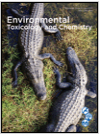Comparison of chronic mixture toxicity of Ni-Zn-Cu and Ni-Zn-Cu-Cd mixtures between Ceriodaphnia dubia and Pseudokirchneriella subcapitata.

Scientific abstract
Although aquatic organisms in the environment are exposed to mixtures of metals, risk assessment for metals is most commonly performed on a metal-by-metal basis. To increase the knowledge about chronic mixture effects, the authors investigated whether metal mixture effects are dependent on the biological species, mixture composition, and metal concentration ratio. The authors evaluated the effects of quaternary Ni-Zn-Cu-Cd and ternary Ni-Zn-Cu mixtures on 48-h algal growth rate (Pseudokirchneriella subcapitata) and 7-d daphnid reproduction (Ceriodaphnia dubia) using a ray design. Single metals were 3-fold to 42-fold more toxic for C. dubia than for P. subcapitata, based on the 50% effective concentration expressed as free metal activity, the range representing different metals. Statistical analysis of mixture effects showed that the ternary and quaternary mixture effects were antagonistic on algal
growth relative to the concentration addition (CA) model, when the analysis was based on dissolved concentrations and on free metal ion activities. Using the independent action (IA) model, mixture effects in both rays were statistically noninteractive for algal growth when the analysis was based on dissolved concentrations; however, the interactions shifted toward antagonism when based on free ion activities. The ternary Ni-Zn-Cu mixture acted antagonistically on daphnid reproduction relative to both reference models, either expressed as free ion activities or dissolved concentrations. When Cd was added to the mixture, however, the mixture effects shifted toward noninteractivity for daphnids. The metal concentration ratio did not significantly influence the magnitude of observed antagonistic effects. Regardless of statistical interactions observed, based on the present study, CA and in most instances also IA can serve as a protective model for ternary Ni-Zn-Cu and quaternary Ni-Zn-Cu-Cd toxicity to both species.
Full reference (link)
Nys C, Van Regenmortel T, Janssen, CR, Blust R, Smolders E, De Schamphelaere KAC. 2017. Comparison of chronic mixture toxicity of Ni-Zn-Cu and Ni-Zn-Cu-Cd mixtures between Ceriodaphnia dubia and Pseudokirchneriella subcapitata. Environmental Toxicology and Chemistry 36, pp 1056-1066.
